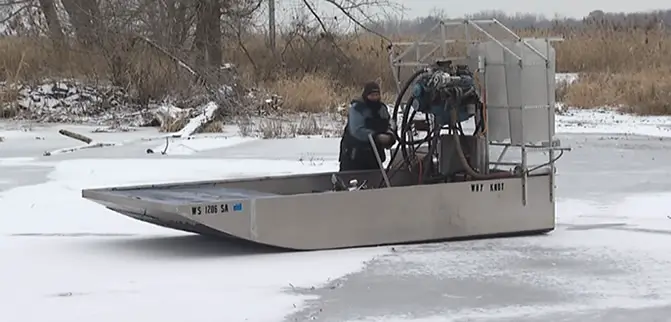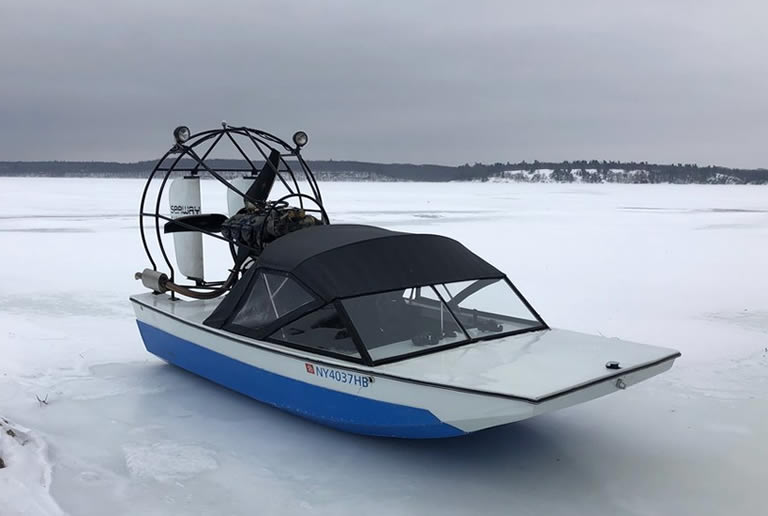Contents
Can An Airboat Go On Ice Safely?
An airboat can easily move over ice.
As an airboat has a flat bottom hull and no moving parts underneath the hull, it can effortlessly glide across ice at speed.
Because the engine and propeller are located at the rear, and on, the boat an airboat can be propelled without the need for water.
Why an airboat can go on ice
Okay, so an airboat can used on ice but why is this?
Good question. It’s all down to the flat bottom hull design and the fact that the propeller is located on the boat instead of under it.
The hull of an airboat is designed to give the boat a shallow draft.
The shallow draft simply means the airboat can be used in very shallow water – it doesn’t sit deep in the water but sits not far below the waterline i.e. it sits “shallow”.
To give a boat a shallow draft most boat manufacturers will give it a flat bottom and low freeboard.
The flat bottom means the deepest part of the boat does not sit deep in the water, like a deep draft boat used in the ocean does for example.

This flat bottom hull design has another advantage though, in that it allows the boat to glide over obstacles at the bottom without snagging on them.
Obviously this flat bottom design works perfectly on ice.
Think of a giant sled with its flat bottom and how it glides effortlessly over ice. An airboat hull does the same thing.
So, if it is all about the flat bottom then why can’t other flat bottom boats be used on ice as well?
As I covered in the article about airboats being used on land I will take the humble Jon boat, as an example of a typical and common flat bottom boat, to explain why an airboat can travel over ice but other flat bottom boats cannot.
The Jon boat, both the traditional and mod v type, have a flat bottom hull just as an airboat does.
This means that a Jon boat could easily glide across ice the same way that an airboat can – at least in theory. So why isn’t it used to do that?
A Jon boat cannot be used on ice because, although it will easily glide across the slippery surface, there is no way of propelling the boat when it is on the ice.
Where an airboat can use the giant fan at the rear of the boat to push itself forward a Jon boat needs an outboard motor, a paddle or oars in order to be moved.
Whatever propulsion aid it uses, that propulsion aid requires water to function.
An airboat has no such limitations. All it needs is air and its fan!
So, basically if you could fit a fan to the back of a Jon boat, or any other flat bottom boat, it could also be used on ice and some people have even done that.
However, technically speaking a Jon boat, or any flat bottom boat, with a fan on it immediately becomes an airboat!
What type of airboats cannot go on ice?
There are certain types of airboats that cannot be used on ice though these types are less likely to be found in ice-covered regions.
Before the introduction of carbon composite propeller blades, which greatly reduce the noise that is generated by an airboat fan, many airboat owners sought different ways to reduce the noise levels of their boats.
This was especially the case in Florida where an airboat owner must, by law, fit a noise reduction system to their boat.
How did they do this?
The most common way airboat owners approached this noise problem was to fit mufflers to the boat to help dampen the sound of the exhaust.
However, this is not the only approach that was used.
It is also possible to relocate the exhaust system from on the boat to underneath it. This greatly reduces the sound from the boat as the water acts as a natural sound dampener.
However, placing the exhaust underneath the boat means it no longer has a smooth flat surface that can glide over the ice.
Therefore airboats that have been modified with sound dampening systems, which rely on the relocation of the exhaust system to a place below the boat, are incapable of being used on ice.
The exhaust system would get mangled completely. Luckily though, as most of these boats are located in Florida it is unlikely to be a problem for citizens of the Sunshine State.
Airboat maneuvers on ice (video)
Ice & Water Aren’t The Only Surfaces An Airboat Can Go On
Airboats can also be used on flat land surfaces for all the same reasons it can be used on ice.
The flat bottom hull design means it will glide over grassy and muddy land areas just as easily as it will glide over ice.
In many airboat tours, especially in Florida and Mississippi airboat operators will take an airboat onto a land bridge to move from one body of water into another.
Summary: Why An Airboat Can Be Used On Water, Land & Ice
An airboat can move easily on ice because of its basic design characteristics.
The hull design of an airboat means its flat bottom easily glides over ice.
But unlike other fat bottom boats that rely on underwater propellers and manual propulsion methods that need water to function, an airboat has no moving parts below the water so there is nothing to snag on the ground.
As the propulsion system of the boat is also located on the boat, rather than underneath it, and does not require water to function an airboat can be propelled in non-water environments.
The fan at the rear of an airboat pushes air behind the boat thus allowing it to use motorized propulsion on and off the water.
An airboat can also be used over flat land especially grassy and muddy areas.

